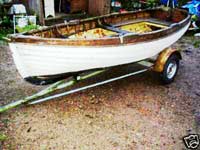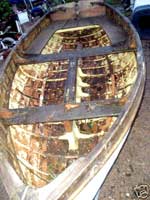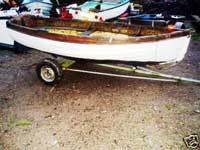|
Lines in the Sand |

|
|
by Alistair Wasey - Great Britain
The Boat That Never Was
|
|
Kids know what a boat looks like. There's some kind of racial memory built in to our genes such that from our earliest days, boats are bi-dimensional trapezoidal blocks with a triangle of white above them that, in time, we learn is called a sail. Everyone knows what a boat looks like.
As we become older our world changes a little; we grow in knowledge, experience and artistic ability. We read the standard texts for aspiring sailspersons and then everyone knows that sails can be square, or triangular and boats are most often made of wood (that's why they float!). Lovers of Ransome will know instinctively that boats are lug-rigged, almost always clinker-built and that fixed keels are somehow implicitly superior to leaky centreboard trunks (although one is never subsequently quite certain why!). Later we learn that boats come in all sorts of different shapes and sizes and that if we strap a motor on the back they go a lot faster for a lot less effort. Life kicks in and the necessity of keeping the wife out of the wind and the kids entertained means that boats can look like... well, almost anything really.
 |
real boats are planked in oak, framed in ash, and rivetted together with fine copper boat nails.
(click images for larger views) |
|
But some folk never make it past the second stage. Whatever the wonderful technological breakthroughs of the past two decades, we know that real boats are planked in oak, framed in ash, and rivetted together with fine copper boat nails. They weigh twice that of their modern equivalent, go at half their speed in light airs, but are four times as strong and eight times the boat when the tops of the waves are streaking past in the wind. Usually.
Ever since I knew what a "real" boat looked like I'd been after one, but I had more or less accepted that the day I could afford one would be the same day as I started drawing my pension. This was, in part, due to a very exacting specification: I would need a boat weighing less than five hundred kilos on her trailer, which would make her about a ten footer. Naturally she'd have to be gaff rigged, with a centre board (what would Ransome say?!) and built like they used to make 'em. Oh, and the trailer needed to be roadworthy and she had to be tatty enough for me to afford her. Rather much to ask of Providence!
But on occasion I'd stick my head around a boat yard, have a surf around ebay, find an occasional wreck, dream a little, then remember that my trailer was built for lightweight loads and all of the boats were either too far away or needed too much work to make them anything like worthwhile.
| her paint was flaking badly and her wood was discoloured. But under that, anyone could see the sweetness of her lines; the stout little ship she'd become when her keel was wetted again. |

|
|
Until I found her! Ten feet long, lying on a trailer, her full rig intact, and sound except for a single cracked rib. Most importantly, she could be mine for a measly two hundred pounds. I could afford two hundred pounds. Okay, she wasn't pretty: her varnish had faded, cracked or disappeared completely; her paint was flaking badly and her wood was discoloured. But under that, anyone could see the sweetness of her lines; the stout little ship she'd become when her keel was wetted again. You could almost feel her tiller pressing your hand and the strain in the sheet as she punched playfully through a short chop in a brisk wind, sending a fine spray back to cool your face. She was perfect.
So I did the only thing that a sensible man could do. I got permission from the better half and started to work out how I'd move her the two hundred miles from Winchester to my workshop where her transformation could be effected. There was a little over three days left on the auction, and one or two tricky challenges to overcome in very short order!
A boat weighing a third of a tonne needed trailing. But would that trailer hold up to two hundred miles after rolling probably no further than from one side of a shed to another for heaven knew how long? What would happen if a bearing ran hot? How would I get her home then? And moreover, what could I tow her with? Was my car's dubiously healthy gearbox up to the job of towing a heavy boat on a questionable trailer the length of the country?
After chatting with a few contacts I managed to get hold of a van that she'd just fit into, on her side, with the trailer wedged in beside her. She'd travel in safety and style and I could check those trailer bearings at my leisure, my investment and new love safe behind the cab. A couple of friends were interested in coming on the road trip to collect her and drop her off at my workshop. Everything was set. All I had to do was wait, hope no one outbid me, and finalise the deal.
 |
There was nothing I could do. Nothing. She had set her sail and drifted away, heaven only knew where to, and I had missed her by a few fractions of a second.
|
|
We had twenty hours to go when we left the pub with everything settled, so I got some sleep and waited to put in my bid until the last minute - just so I didn't provoke anyone into bidding too hard against me. With seven hours to go, everything looked fine, still no bids, she surely had to be mine. Five hours to go, no problem. Two and a half hours, still good.
Then I got cold feet: I would put my bid in earlier than intended. I didn't want to risk anything going wrong. This was probably the only chance I'd ever have of owning my dream boat. I couldn't let it go wrong. I couldn't let her slip away.
And then she did.
As I went to punch in my bid the screen changed: "Auction ended early."
There was nothing I could do. Nothing. She had set her sail and drifted away, heaven only knew where to, and I had missed her by a few fractions of a second.
I never did get to know her name.
Best Wishes
Alistair Wasey

|